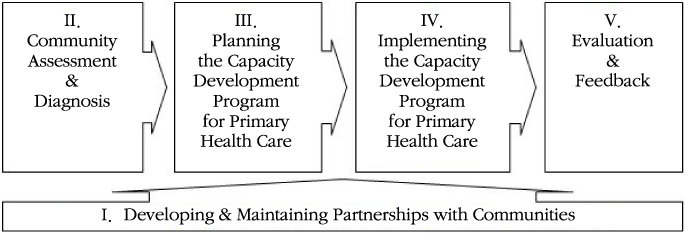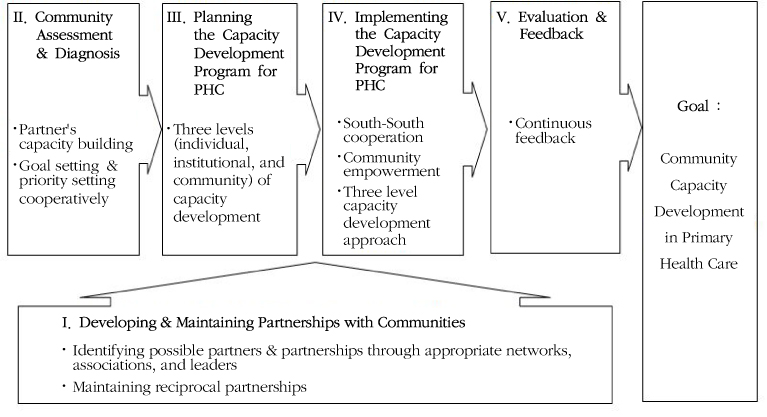J Korean Acad Community Health Nurs.
2010 Mar;21(1):31-42. 10.12799/jkachn.2010.21.1.31.
Development of a Community-based Participatory Global Health Project Model for Primary Health Care Capacity Development: A Case Study from a Rural Community in Ecuador
- Affiliations
-
- 1Graduate School of Public Health, Seoul National University, Korea.
- 2College of Nursing, Yonsei University, Korea.
- 3School of Medicine, Soonchunhyang University, School of Medicine, Korea.
- 4College of Nursing, Nursing Policy Research Institute, Yonsei University, Korea. hlee39@yuhs.ac
- KMID: 2292910
- DOI: http://doi.org/10.12799/jkachn.2010.21.1.31
Abstract
- PURPOSE
The aims of this study were to identify successful strategies and propose a community-based participatory global health project model for primary health care capacity development.
METHODS
The study used case study methodology. A unit of analysis was an international cooperation health project entitled "Community-based Primary Health Care Improvement in San Lorenzo, Ecuador" using community-based participatory research conducted in 2007~2008. Data were collected through windshield surveys, focus group discussion, and provider surveys.
RESULTS
Identified successful strategies for the international cooperation health project were reciprocal partnerships between researchers and community, partners' capacity building, south-to-south cooperation, and continuous monitoring and feedback. Community participation was found to be an essential tenet to guarantee the improvement of primary health care in the underserved rural community. Evidence from the activities of community health practitioners in Korea was applicable to the development of training programs for primary health care providers in Ecuador.
CONCLUSION
Strategies for primary health care capacity development may be tailored depending on socio-cultural, political, and economical situations of each country. The model, however, would be applicable to the entire process of community-based global health projects in underserved rural communities of other countries.
Keyword
MeSH Terms
Figure
Cited by 2 articles
-
Evaluation of a Community-based participatory professional periodontal care program for hypertension and diabetes patients
Su-Kyung Park, Ga-Yeong Lee, Yeun-Ju Kim, Min-Young Lee, Do-Hwa Byun, Kyung-Hee Kim, Hyo-Rim Son, Chun-Bae Kim, Yang-Heui Ahn, Nam-Hee Kim
J Korean Acad Oral Health. 2017;41(1):56-64. doi: 10.11149/jkaoh.2017.41.1.56.Development and Effect of a Global Health Capacity Building Program for Nursing Students
Seon Young Hwang, Jin Sun Kim, Hyunmi Ahn, Sun Joo Kang
J Korean Acad Community Health Nurs. 2015;26(3):209-220. doi: 10.12799/jkachn.2015.26.3.209.
Reference
-
1. Altman DG. Sustaining interventions in community systems: On the relationship between researchers and communities. Health Psychol. 1995; 14(6):526–536.
Article2. Barrios E, Delve RJ, Bekunda M, Mowo J, Agunda J, Ramisch J, et al. Indicators of soil quality: A South-South development of a methodological guide for linking local and technical knowledge. Geoderma. 2006; 135:248–259.
Article3. Centers for Disease Control and Prevention. Policy statement for core research projects. 2006. Retrieved September 30, 2009. from http://www.cdc.gov/prc/research-projects/program-policy.htm.4. deKoning K, Martin M, editors. Participatory research in health: Issues and experiences. London: Zed Books;1996.5. Freire P. Education for critical consciousness. New York: Seabury Press;1973.6. Fukuda-Parr S, Lopes C, Malik K, editors. Capacity for development: New solutions to old problems. New York: United Nations Development Programme;2002.7. Gebbie K, Rosenstock L, Allan S, Bender K, Blazer D, Burris S, et al. Who will keep the public healthy? Educating public health professionals for the 21st century. Washington, DC: Institute of Medicine, National Academy of Sciences;2002.8. Israel BA, Eng E, Schulz AJ, Parker EA. Methods in community-based participatory research for health. San Francisco: Jossey-Bass;2005.9. Israel BA, Schulz AJ, Parker EA, Becker AB, Allen A, Guzman JR. Critical issues in developing and following community-based participatory research principles. In : Minkler M, Wallerstein N, editors. Community-based participatory research for health. San Francisco: Jossey-Bass;2003. p. 56–73.10. Karmaliani R, McFarlane J, Asad N, Madhani F, Hirani S, Shehzad S, et al. Applying community-based participatory research methods to improve maternal and child health in Karachi, Pakistan. Nurs Outlook. 2009; 57(4):204–209.
Article11. Kellogg Foundation, W. K.Kellogg health scholars program. 2002. Retrieved October 7, 2009. from http://www.kellogghealthscholars.org/about/community.cfm.12. Kim HJ, Yoon SN, Chun KJ, Kim SY, Kim CM, Kim HS, et al. Community health nursing. Seoul: Sumoonsa;2008.13. Kim MI, Cho WJ, Kim ES, Chung YS, Kang HY, Lee JR. Client-centered community health nursing. Seoul: Hyunmoonsa;2002.14. Lawn JE, Rhode J, Rifkin S, Were M, Paul VK, Chopra M. Alma-Ata 30 years on: Revolutionary, relevant, and time to revitalize. Lancet. 2008; 372(9642):917–927.15. Minkler M. Community-based research partnerships: Challenges and opportunities. J Urban Health. 2005; 82:Suppl 2. (2):3–12.
Article16. Rifkin SB. Lessons from community participation in health programmes: A review of the post Alma-Ata experience. Int Health. 2009; 1:31–36.
Article17. Schensul JJ, Denelli-Hess D, Borreo MG, Bhavati MP. Urban comadronas: Maternal and child health research and policy formulation in a Puerto Rican community. In : Stull DD, Schensul JJ, editors. Collaborative research and social change: Applied anthropology in action. Boulder, Co: Westview Press;1987. p. 9–32.18. Stringer ET. Action research: A handbook for practitioners. Thousand Oaks, CA: Sage;1996.19. Suarez-Balcazar Y, Davis MI, Ferrari J, Nyden P, Olson B, Alvarez J, et al. University-community partnerships: A framework and an exemplar. In : Jason LA, Keys BC, Suarez-Balcazar Y, Taylor RR, Davis MI, editors. Participatory community research: Theories and methods in action. Washington, DC: American Psychological Association;2004.20. Viswanathan M, Ammerman A, Eng E, Gartlehner G, Lohr KN, Griffith D, et al. Community-based participatory research: Assessing the evidence. Summary, evidence report/Technology assessment No. 99. AHRQ Publication 04-E022-1. Rockville, MD: Agency for Healthcare Research and Quality;2004.21. World Health Organization. World health statistics 2008. 2008-a. Retrieved December 28, 2009. from http://www.who.int/whosis/whostat/EN_WHS08_Full.pdf.22. World Health Organization. World health report 2008: Primary health care. 2008-b. Retrieved December 28, 2009. from http://www.who.int/whr/2008/whr08_en.pdf.23. World Health Organization. Community health nursing report of a WHO expert committee (Technical Report Series No. 558). Geneva: World Health Organization;1974.24. Yoo SH. Using community-based participatory research (CBPR) for health promotion. J Korean Soc Health Educ Promot. 2009; 26(1):141–158.
- Full Text Links
- Actions
-
Cited
- CITED
-
- Close
- Share
- Similar articles
-
- The role and responsibility of community health practitioner based on the rural community development and the reform of health care system
- The direction of reform for enhancing primary care
- New Evaluation Vector through the Stanford Mobile Inquiry-Based Learning Environment (SMILE) for Participatory Action Research
- Intervention Model Development of Health Promotion for Women Workers in Traditional Marketplaces: Using Community based Participatory Action Research
Community-Based Participatory Project to Reduce Health Disparity: Focusing on the Residents’ Autonomy Council



